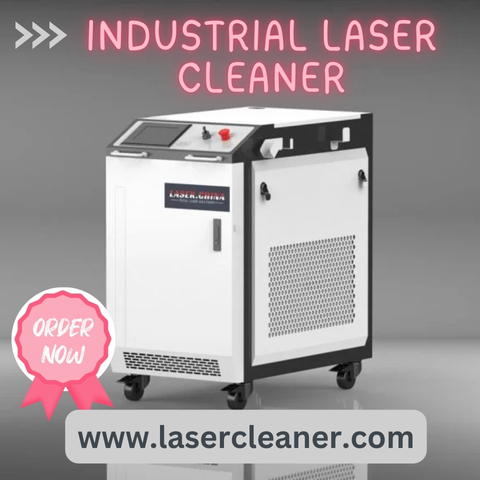Industrial environments are constantly evolving, and cleaning techniques have come a long way from traditional abrasive or chemical methods. Among the latest technological advancements in industrial maintenance and surface preparation, the industrial laser cleaner has emerged as a transformative tool, reshaping the way manufacturers approach surface cleaning, rust removal, paint stripping, and precision maintenance. Its rise in popularity is not just due to technological innovation but also because of the efficiency and control it offers over traditional methods.
At its core, an industrial laser cleaner uses high-intensity laser beams to remove contaminants, rust, and coatings from various surfaces. Unlike conventional mechanical or chemical cleaning, this method works with precision at the microscopic level, ensuring that the underlying surface remains unharmed while the unwanted material is effectively eliminated. This level of precision has opened up opportunities across industries where surface integrity is critical, such as aerospace, automotive, electronics, and heavy machinery maintenance.
The principle behind industrial laser cleaning is surprisingly straightforward. Laser beams interact with the material on the surface, causing it to vaporize or break down without the need for physical abrasion. The process generates minimal waste, which is typically in the form of fine dust or vapor, making it environmentally preferable in situations where chemical waste or secondary pollution is a concern. This method allows operators to clean complex surfaces, intricate shapes, and hard-to-reach areas that traditional tools would struggle to address.
Industrial laser cleaners are versatile and capable of handling a wide range of materials. Metals like steel, aluminum, copper, and titanium can be cleaned efficiently, as well as non-metal surfaces in some applications. The technology is adaptable to different power levels, wavelengths, and pulse durations, allowing for customization depending on the type of contamination, surface condition, and desired cleaning depth. This flexibility has contributed to the growing adoption of laser cleaning in production lines, maintenance workshops, and restoration projects.
One of the key trends driving industrial laser cleaner adoption is the focus on minimizing downtime and maximizing production efficiency. In large-scale manufacturing or maintenance environments, time spent on cleaning is often seen as non-productive. Traditional cleaning methods, whether abrasive blasting or chemical stripping, can require significant preparation, handling of hazardous substances, and extensive post-cleaning procedures. Industrial laser cleaners, however, streamline the process, offering faster cleaning cycles and reduced need for manual intervention.
Safety considerations are also important when implementing industrial laser cleaners. While the technology eliminates many risks associated with chemicals and abrasives, operators must follow proper guidelines for laser safety. This includes using protective eyewear, shielding equipment, and ensuring controlled operational environments. Modern industrial laser systems often incorporate built-in safety features, such as interlocks, automated shutdowns, and user-friendly interfaces to maintain a secure and efficient operation.
In addition to maintenance and cleaning, industrial laser cleaners are playing a significant role in material preparation for further processing. For instance, in the aerospace or automotive industries, surfaces must often be prepared for welding, coating, or bonding. Laser cleaning ensures the surface is free from oxides, oils, and other residues, improving adhesion and overall performance in subsequent manufacturing steps. This level of precision helps maintain consistent product quality and reduces the risk of failure due to contamination.
The integration of industrial laser cleaners into production workflows has been supported by advancements in automation. Robotic arms and CNC-controlled systems can be paired with laser cleaning heads to handle large-scale or repetitive cleaning tasks with consistent results. This automation reduces labor-intensive work and ensures repeatable quality across multiple components, whether cleaning engine parts, mold surfaces, or delicate electronics.
Environmental considerations also favor the use of industrial laser cleaners. Unlike chemical-based processes, laser cleaning generates no liquid waste or hazardous runoff. The residue is typically minimal and easily contained, which is especially valuable in industries with strict environmental regulations. By reducing the reliance on chemical solvents, companies can improve workplace safety and reduce the environmental footprint of their operations.
Industrial laser cleaning is also making an impact in restoration and heritage projects. Historical artifacts, sculptures, and industrial machinery with historical significance require careful cleaning without damaging the original surface. Laser technology offers a level of control that allows for the removal of corrosion, soot, and old coatings without affecting the material’s integrity, making it an invaluable tool for conservation specialists.
Training and knowledge are key factors for successful implementation. While the operation of laser cleaning systems is increasingly intuitive, understanding the interaction between laser parameters and material types is critical for achieving optimal results. Companies adopting industrial laser cleaners often invest in training operators to recognize surface conditions, select appropriate settings, and perform routine maintenance to ensure consistent performance.
From industrial maintenance to high-precision manufacturing, the impact of industrial laser cleaners continues to grow. Their ability to handle a wide variety of materials, minimize environmental impact, reduce downtime, and enhance surface preparation makes them a versatile solution in modern industrial operations. As technology continues to evolve, we can expect further improvements in power efficiency, portability, and integration with automated systems, further solidifying the industrial laser cleaner as an essential tool in contemporary production and maintenance workflows.
Final Thoughts
The industrial laser cleaner represents a significant shift in how industries approach surface maintenance and preparation. Its precision, efficiency, and adaptability make it a valuable addition across diverse sectors, from manufacturing to restoration. By reducing manual labor, minimizing waste, and maintaining surface integrity, industrial laser cleaners are not just tools—they are strategic assets that enhance productivity, quality, and sustainability in modern industrial environments.
 WhatsApp Us Now
WhatsApp Us Now









